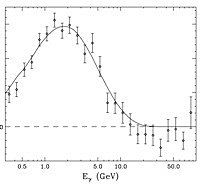Starting
March 31, I’ll be teaching a cosmology course at UCLA’s Osher Institute —
hope to see you there! Titled “Our Universe: the Known and the
Unknown”, the class meets in Sherman Oaks, California, on Mondays from
1-3pm for 6 consecutive weeks. For more details, click here.
We’ll cover everything you always wanted to know about our universe, including the following hot new results on dark matter.
A newly
refined analysis of data from NASA’s FERMI gamma ray space telescope
provides the most promising detection yet of dark matter. For about
three years, FERMI observed a higher than expected gamma ray flux coming
from the center of our galaxy, the Milky Way. Gamma rays are the
highest energy form of light. Some scientists suggested the origin of
these gamma rays was dark matter, while others suspected thousands of
unseen millisecond pulsars — rapidly spinning neutron stars with immense
magnetic fields.
By
selecting only gamma rays with the most precisely measured incoming
directions, the FERMI team was better able to localize their origin. The
new analysis shows they do not come from many point sources, such as
pulsars, but rather originate from a broad region surrounding the Milky
Way center. Moving outward from the center, the gamma ray excess
decreases rapidly, but is detectable out to a distance of 5000
light-years, as seen below. (For comparison, we are about 26,000
light-years from the galaxy center.) This makes sense — one would expect
heavy dark matter particles to accumulate at the bottom of the
gravitational potential well at the center of our galaxy.

FERMI telescope image of entire sky showing
excess gamma rays coming from Milky Way’s center
The new FERMI data seem to exclude pulsars and all other known sources, except dark matter.
These data
suggest dark matter particles are annihilating with corresponding dark
matter antiparticles, with the resulting gamma rays shooting out in all
directions. The data fit a dark matter particle mass of 30 to 40 GeV, as
seen below. That’s about 35 times heavier than a proton and about ¼ of
the Higgs boson’s mass.

Energy spectrum of excess gamma rays.
Diamonds indicate FERMI data points, with
vertical bars denoting experimental uncertainties.
Humped curve indicates the expected gamma ray
spectrum from annihilation of particles of mass 35 GeV.
While prior
studies of dwarf galaxies seemed to exclude dark matter particles with
masses below 40 GeV, the signal strength in this new study is hundreds
of times higher because we are so much closer to our galaxy’s center
than to the dwarf galaxies that orbit the Milky Way.
The mass
and density of dark matter particles inferred from this new FERMI data
is roughly compatible with cosmic microwave background measurements from
the WMAP and PLANCK satellites. The FERMI data is also consistent with
dark matter being composed of WIMPs (Weakly Interacting Massive
Particles), theorists’ favorite dark matter candidate. It seems WIMPs
will beat out the competing MACHOs (Massive Compact Halo Objects).
We should
be cautiously optimistic about this new development. Experiments to
detect dark matter have suffered many false starts, with several
reporting one to three questionable dark matter candidates. None of
these “detections” were widely accepted. But, the FERMI data are far
more robust than those earlier works. In this experiment, the dark
matter signal amounts to 30,000 gamma rays per square meter of detector.
We may soon gain some real insight into the greatest current mystery of particle physics.
Best Regards,
Robert
Mar 17th, 2014
|